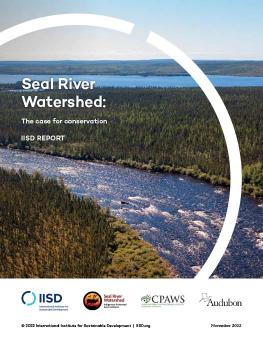
Seal River Watershed: The case for conservation
The Seal River Watershed Indigenous Protected Area (IPA) Initiative is an Indigenous-led conservation project that aims to establish a protected area under the active stewardship of Indigenous Peoples. This report presents an overview of the value of the Seal River Watershed, including its environmental, social, cultural, and economic value, and discusses the significance of protecting it for future generations. The report further lays out the benefits and considerations for establishing the Seal River Watershed IPA in Manitoba based on existing Canadian examples.
-
Canada and Manitoba are unlikely to meet or scale up their conservation targets without the support and involvement of Indigenous communities.
-
The Seal River Watershed provides important benefits to Manitobans and the world, ranging from habitat for threatened species to sustaining the cultures of Indigenous Peoples and promoting Northern tourism.
The Seal River Watershed is located in northern Manitoba, Canada, and encompasses an area of 50,000 km2, nearly 8% of the province. Due to its remote, pristine environment, the watershed holds immense value from environmental, cultural, social, and economic perspectives, including:
- Biodiversity: The watershed is home to an estimated 250 bird species and at least 350 species of other taxa, including 48 mammal species.
- Carbon storage: It stores an estimated 1.7 billion tonnes of carbon, equivalent to 6.2 billion tonnes of CO2, valued at CAD 314.5 billion.
- Indigenous culture: The pristine nature of the watershed allows members of the Sayisi Dene First Nation, Northlands Denesuline First Nation, Barren Lands First Nation, and O-Pipon-Na-Piwin Cree Nation to maintain a connection to their culture and identity.
Establishing the Seal River Watershed IPA presents a unique opportunity to protect this important ecosystem for future generations and for the Indigenous communities to share their Traditional Knowledge, history, and culture with visitors from Canada and around the world.
To support the Seal River Watershed IPA Initiative, the government of Manitoba can:
- Adopt interim measures to protect the watershed from commercial resource extraction and development.
- Establish a Seal River Watershed IPA committee or working group to undertake a feasibility study and identify provincial legislative options for establishing an accompanying Crown designation for the watershed.
- Provide in-kind technical and communications support for the Seal River Watershed Alliance, partner nations and organizations.
You might also be interested in
How Can We Work With Nature to Tackle Drought and Desertification?
Drought is one of the most devastating and pervasive challenges exacerbated by climate change. However, we can work to reduce its effects through nature-based solutions for land restoration and climate-smart agriculture.
Estimate of Natural Infrastructure Public Grant Funding in Canada and in the Canadian Prairies
This analysis estimated the amount of public grant funding available across Canada and in the Canadian Prairie provinces for investing in urgently needed natural infrastructure.
The Critical Next Step: What you need to know about Canada’s 2030 climate target
Canada's climate target for 2030 is within reach, but more stringent policies and clearer government communication will be needed to get there. Our expert explains why these developments are critical for Canada to help avoid the worst impacts of climate change.
Ottawa supports Big Oil over the climate
One can only imagine the positive buzz these days inside the boardrooms of Canada's oil companies, as they rake in record profits and plan major expansions of their oil production. Amid all the good cheer, one could easily lose sight of the fact that those plans will push the world dangerously closer to the brink of irreversible climate chaos. Even as the world finally signed a commitment at UN climate talks last month to begin transitioning away from fossil fuels, Canada's major oil companies are poised to do exactly the opposite — to greatly expand their fossil fuel production.